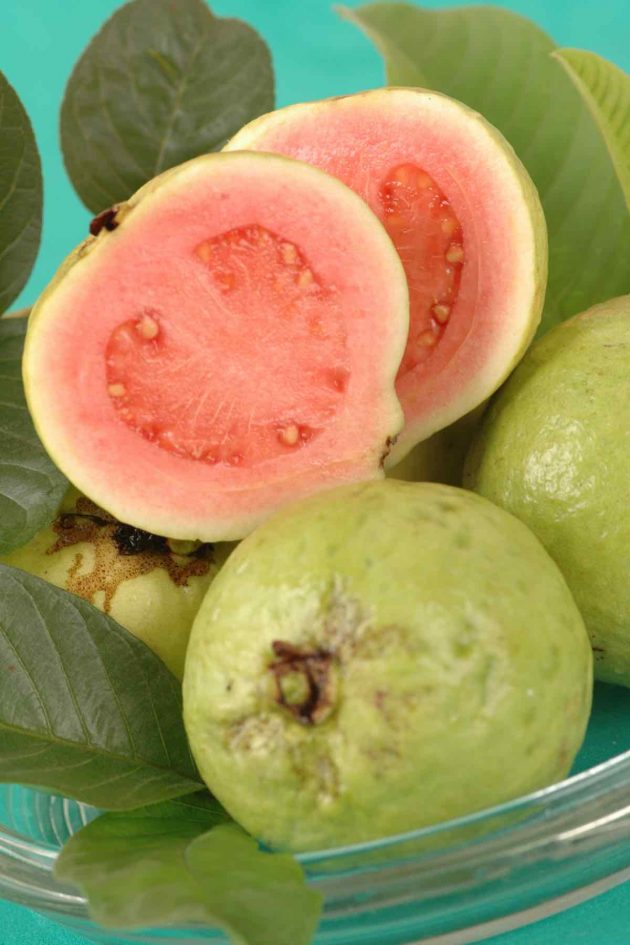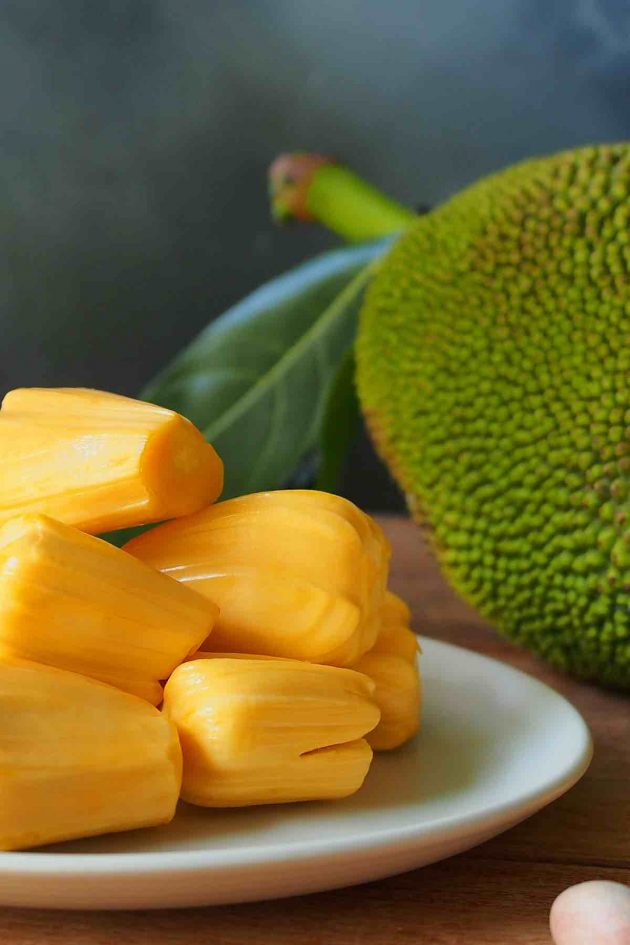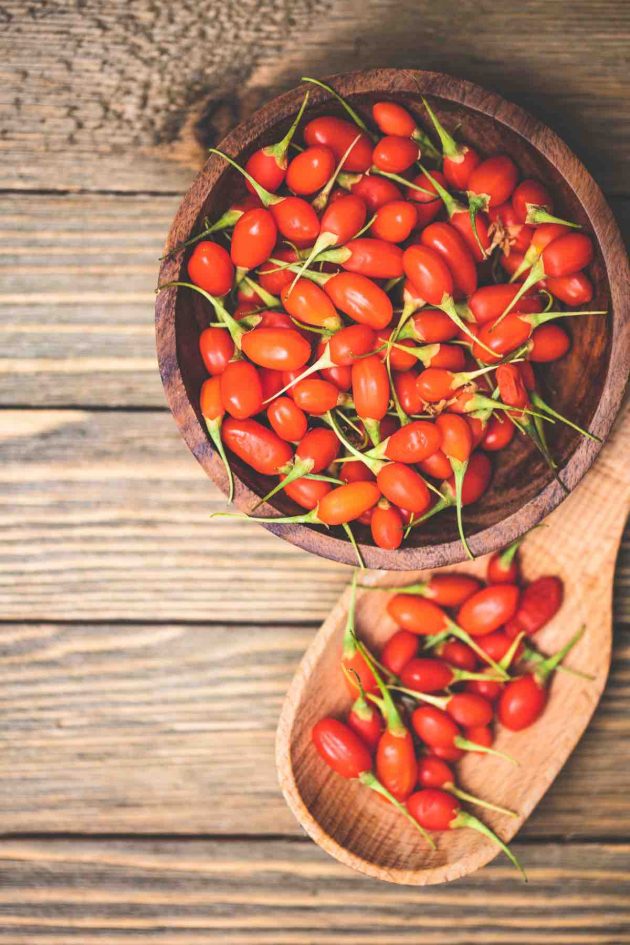34 Exotic Fruits: Names and Pictures
This post may contain affiliate links. Please read the disclosure policy.
Are you looking for delicious exotic fruits from all over the world? From tropical Caribbean fruits to Asian berries, there is an exotic fruit for every taste. They’re also nutritious with a range of health benefits!

Ever notice how new exotic fruits keep popping up at your favorite supermarket? It’s no coincidence that demand for tropical fruits is on the rise thanks to their appealing tastes and health benefits.
Here we’ve got exotic fruit names and pictures, starting with most common and finishing with the downright weird. So friends, keep reading and discover a new favorite!
What Are Exotic Fruits?
In the U.S., exotic fruits refer to fruits that do not originate in North America and/or cannot grow here. Examples include the lychee fruit of Southeast Asia and the passion fruit from South America.
What Is the Most Exotic Fruit Ever?
The miracle fruit (also known as miracle berry or by its scientific name of synsepalum dulcificum) is one of the most exotic fruits. The berries can alter your tongue’s perception of taste, making sour foods taste sweet! They are native to West Africa and seldom found on the North American continent.
Top 10 Exotic Fruits
Here are the top-10 most widely available exotic fruits in America:
1. Pitaya (Dragon Fruit)

Dragon fruit originated in Central and South America and is actually a type of cactus flower. The flesh has a very mild flavor with just a hint of sweetness. You can enjoy it on its own as a snack or add to fruit salads and smoothies.
In addition to pink-skinned varieties above, there is also yellow dragon fruit with a slightly sweeter taste.
2. Guava

Guava is a delicious tropical fruit grown in the Caribbean and South America. It’s actually a type of berry with bright pink or white flesh. Guava has a refreshing, sweet taste and a range of health benefits.
3. Papaya

Papaya is a sweet fruit with a distinctive flavor and lots of health benefits. Also called pawpaw, it makes a delicious snack or addition to desserts and smoothies.
Just note that papaya contains trace amounts of latex, making it unsuitable if you are pregnant.
4. Pomegranate

The pomegranate is a tropical fruit thought to have originated in Persia and now cultivated around the world including in Florida and California.
Pomegranates are prized for their sweet and tart flavors along with their powerful antioxidants. You need to break them open to expose the pods (called arils) inside. Eat them as a snack, juice them or add to a fruit salad.
5. Passion Fruit

Passion fruit was first discovered in subtropical South America. This exotic fruit is fragrant with a bright, tart flavor and crunchy seeds.
You can eat it with a spoon or make it into a tropical-flavored drink. Passion fruit provides vitamins A and C, a variety of nutrients and dietary fiber.
6. Lychee

Lychees are prized for their sweet white flesh and distinctive refreshing flavor. These juicy tropical fruits are native to southeastern China, where they have been cultivated for centuries.
Just be sure to avoid eating the large pits in the middle, as they have toxic properties just like cherry pits.
7. Persimmon

Persimmons, sometimes called kaki, may resemble orange tomatoes, but these fruits have a totally distinct honey-like flavor.
Originally from China, these fruits have been cultivated in Midwestern states such as Illinois, where persimmon pudding is a popular dessert! There is also the black sapote or black persimmon with a slightly chocolatey flavor.
8. Durian

Durian is a tropical fruit with a distinctive spiny exterior, mild-tasting flesh and potent aroma! That’s right, most people consider it to have an unpleasant sweaty smell. It was first discovered in southeast Asia and parts of Indonesia. Today, you’ll find it at most Asian markets in the U.S. Fun fact: Durian is a popular pizza topping in China!
Though it has a similar appearance to the jackfruit, the two are not related.
9. Jackfruit

Jackfruit is a mild-tasting tropical fruit native to Western India with good availability stateside. It has become popular as a meat substitute in vegan recipes (think jackfruit tacos), as it can be boiled or roasted and shreds nicely.
10. Pomelo

The pomelo, also called a pummelo or pommelo or pomelo fruit, is the largest citrus fruit growing up to one foot in diameter! Pomelo fruit is high in vitamin C and has a pleasantly mild flavor without the bitterness often found in grapefruit.
While native to China, it’s increasingly available in American supermarkets. Fun fact: It’s not juicy like grapefruit, making it an easy snack to eat on-the-go.
Next-10 on the Exotic Fruits List
Before we get into the more rare exotic fruits, here are more options you may encounter at supermarkets:
11. Star Fruit (Carambola)

This exotic fruit hails from Sri Lanka and today has good availability worldwide. Starfruit flesh has the texture of crisp watermelon with a taste reminiscent of crisp pears.
Starfruit is packed with healthy plant compounds and antioxidants. However, its high oxalate content makes it potentially unsuitable for people with kidney problems.
12. Asian Pear

The Asian pear, or pyrus pyrifolia, is a pear tree native to East Asia. It has a round shape and sand-colored skin with crisp flesh reminiscent of starfruit.
Asian pears are rich in dietary fiber, potassium and vitamin C, among other health benefits.
13. Goji Berries

Goji berries are considered a superfood, making popular among the health-conscious. These berries are indigenous to parts of Asia and have a distinctive taste reminiscent of cranberries, but you can find them at specialty grocers like Whole Foods. Fun fact: You can steep fresh or dried goji berries to make tea!
14. Pepino Melon

Pepino melons is a South American fruit with a refreshing, mild taste that’s a cross between honeydew and cucumber. They come in a variety of colors including light green and purple. Given their long shape, it can be easy to mistake one for an Asian eggplant. Fun fact: This exotic fruit has its own Gatorade flavor called Lime Cucumber!
15. Prickly Pear (Pear Cactus)

The prickly pear, also known as a pear cactus, hails from South America and was imported into Europe in the 15th century! When ripe, the flesh is soft and juicy with small, edible seeds. The flavor is a cross between melon and kiwi with bubblegum notes. It’s rich in dietary fiber, antioxidants and cartenoids among other health benefits.
This mangosteen is native to Southeast Asia and tastes like a cross between lychee, peach and strawberry. The mangosteen tree takes more than a decade to mature and bear fruit, making this fruit expensive to cultivate. That being said, you can increasingly find it at specialty grocers in season between June and August.
16. Rambutan (Chom Chom)

Rambutan has a unique appearance with its red, spiky skin and long, hairlike strands. On the inside, the fruit has sweet, white flesh that looks and tastes a lot like lychee. This exotic fruit originates in Malaysia, where it is also called chom chom, and is harvested in South America as well.
You can often find rambutan at Asian grocers in season between November and February or around August and September.
17. Longan

Longan is often confused with its close relative, the lychee. The longan fruit is juicy and sweet with a grape-like consistency and flavor. Rich in Vitamin C, it’s prized for its health benefits.
While longan is native to India and China, there is wide cultivation in Asia plus a harvest in South Florida from July to September! So you might just see some at Asian supermarkets and specialty grocers.
18. Sugar Apple (Sweetsop)

Also known as sweetsop, this knobby fruit is native to the Caribbean and Latin America. The white flesh has a creamy, custardy texture and a sweet, mild taste.
Just note the sugar apple’s large seeds have toxic properties and should not be eaten!
19. Cherimoya

The cherimoya is a knobby fruit native to Central and South America. This exotic fruit has a sweet white flesh with a creamy and custard-like texture.
Sometimes you’ll see it labelled custard apple, which is technically a hybrid of cherimoya and sugar apple, so not quite the same thing. It’s easy to confuse with the sugar apple (sweetsop), but you can distinguish it by its flatter, mottled skin.
20. Elderberries

Elderberries are small berries are a rich source of vitamins C and B6, and are often used as a natural remedy for colds and the flu. They are native to Scandinavia and the Mediterranean and seldom found fresh in America. However, many specialty grocers and health food stores carry dried elderberries, elderberry powder and elderberry tea.
Rare Exotic Fruits You’ve Properly Never Tried
Here is the moment you’ve been waiting for: the rare, weird and truly exotic fruits on the list!
21. Ackee

The ackee is a soft exotic fruit with a delicate nutty flavor. While it’s native to West Africa, today ackee is the national fruit of Jamaica.
Even though it’s technically a fruit, Jamaicans prefer to combine it with savory seasonings and serve with codfish and vegetables!
22. Mangosteen

The mangosteen comes from the lands around the Indian ocean. It grows on a tropical evergreen tree and boasts a purple color. The skin is tough but the white flesh is sweet and juicy with peach and banana notes.
Mangosteen is rare in the U.S. because the tree takes a decade to cultivate and the fruit spoils easily during transport. You may nonetheless spot it at supermarkets from time to time.
23. Lucuma

Considered a superfood because of its health benefits, Lucuma is an exotic fruit that is native to Peru. It’s used to make a tasty traditional Peruvian ice cream and other desserts.
24. Akebi

This Japanese fruit has a mystical appearance with deep purple skin and translucent white flesh. The Akebi fruit has notes of watermelon and coconut with slightly bitter notes. The pulp has texture reminiscent of dragon fruit.
25. Buddha’s Hand

This unique fruit originated in South or East Asia and gets its name from its unusual shape. The Buddha’s hand is segmented into finger-like sections and is often used as a perfume.
You are unlikely to find it in stores, although there are a few U.S. growers in places like California.
26. Miracle Berry (Miracle Fruit)

This fascinating fruit is native to West Africa and has the power to alter your tongue’s perception of taste. After chewing these magic berries, you will experience a phenomenon known as flavor tripping.
27. Acai

Acai berries grow on large palm trees and are native to the Amazon rainforest. They have become a social media sensation for their purported health benefits, including powerful antioxidants and low sugar content.
Acai berries are almost never available fresh. However, you can usually get them in freeze-fried or powdered form. Occasionally, you’ll find packages in the freezer section at specialty grocers or health food shops!
28. Loquat

Loquat originated in China and was exported to Japan during medieval times. The loquat fruit is sweet with slightly tart, citrusy notes. Eat it fresh or use it to make jellies, syrups and pastries!
29. Salak (Snake Fruit)

Salak, also known as snake fruit for its scaly skin, comes from Indonesia. It has a sweet and tangy flavor remniscent of pineapple, jackfruit and durian. Fun fact: You can make wine out of salak!
Alas, salak is extremely rare to find stateside.
30. Yuzu

Yuzu is a Japanese citrus that is also cultivated in Korea and China. The fruit tastes like a combination of mandarin oranges and grapefruit.
It’s prized for its juice and zest, while also being used to make an oil for perfumes and cosmetics. Yuzu is uncommon in America but I’ve spotted it on occasion at Whole Foods!
31. Yangmei (Chinese Bayberry)

This fruit originated in China and is sometimes known as waxberry or yumberry. The taste can be describes as a mixture of strawberry and pomegranate with the texture of an orange. Imports into the U.S. have begun, so you might come across some if you look hard enough!
32. Genips (Spanish Lime)

Genips are grown in South and Central America and parts of the Caribbean. They are eaten by sucking sweet, juicy gelatinous flesh from the seed of the fruit.
33. Sapodilla

Sapodilla fruits, also known as chikoo, sapota, zapotillo, naseberry, sepadilla and zapote, come from an evergreen tree native to Mexico, Central America and the Caribbean. The flesh is very sweet with pear and brown sugar notes that is sometimes described as being malty.
34. Breadfruit

Breadfruit is a species of flowering tree in the jackfruit family and considered to be native to New Guinea. The taste bear some similarity to potatoes or freshly-baked bread, hence the name.
Exotic Fruit FAQ
The Indonesian fruit salak, also known as snake fruit, is extremely rare in the USA. Similarly, the black sapote is a rare black persimmon with a chocolate-like flavor. Most other exotic fruits have been cultivated in multiple locations around the world with some availability online or in-store.
The best places to find exotic fruits include specialty grocers and ethnic grocers in your area. If you can’t find them there, search online as some local growers will also ship direct to consumer.
Back in the 17th century, American colonists began importing pineapple from the Caribbean to early America. Based on this historical record, the pineapple became the symbol of hospitality, even though it is hardly considered an exotic fruit today.
© TIPBUZZ. Images and text on this website are copyright protected. Please do not post or republish without permission. If you want to republish this recipe, please link back to this post. This post may contain affiliate links. Read the disclosure policy here.






